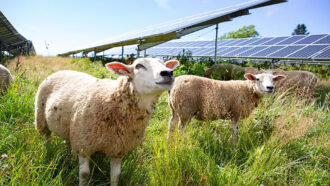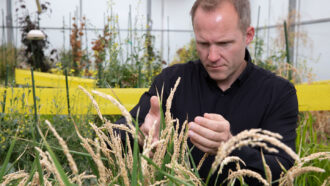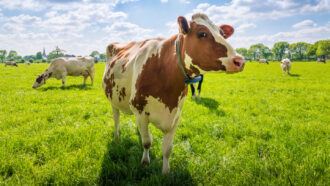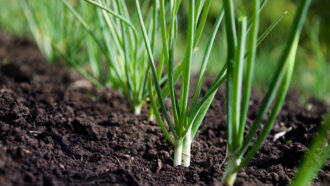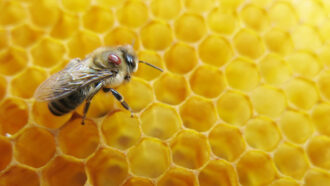New gene resists our last-ditch drug
Tiny loop of DNA can be easily passed between germs
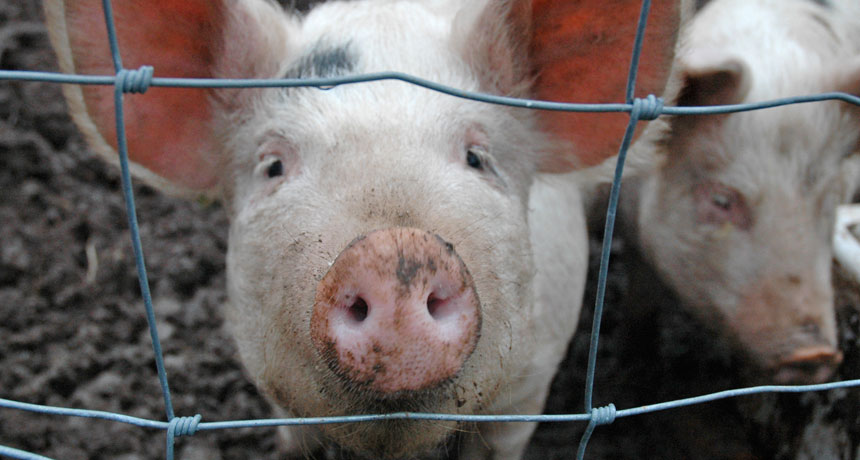
A tiny gene from bacteria found in a pig resists the drug colistin. It’s a drug doctors usually use in people, and only as a last resort.
thornypup/Flickr/(CC BY-NC-ND 2.0)
Antibiotics are drugs that can kill bacteria. But many germs have evolved genes that make them immune to one or more of these drugs. In some cases, only one lone drug remains that can kill them. If bacteria found a way to resist — ignore — that last drug too, these killer germs might be unstoppable. Infections that were once easy to treat would become incurable. And, new data show, bacteria are dangerously close to that scary future.
Scientists have just reported finding a bacterial gene that lets germs resist drugs that doctors use only as a last resort.
The bacteria, discovered in China, can resist the drug colistin. That’s an antibiotic that doctors reserve for the sickest patients, those sick from germs resistant to all other drugs. It’s not time to panic — yet. Instead, scientists say, it’s time to take a hard look at how doctors, and farmers, use antibiotics on a daily basis. That won’t get rid of the colistin-resistant bacteria. But it could help prevent other resistant germs from evolving.
Why colistin resistance is a big deal
Most bacteria die when hit with an antibiotic — a drug doctors use to target them. But a few germs may be lucky. They will have genes — sets of instructions inside them — that allow them to survive the antibiotic and to keep on making someone sick.
Even though bacteria may be resistant to the first drug a doctor tries, there are usually other drugs that can be substituted. But over time, germs can develop an ability to withstand them, too. Sometimes, all that is left are drugs that belong to a group known as polymyxins (PAH-lee-MIX-ins). These antibiotics are toxic in people. That’s why doctors use them only as a last resort. But they will kill off even the hardiest bacteria — allowing people to get well.
Colistin is one of those polymyxins. But “it’s not something that’s routinely tested” for resistance, notes Yohei Doi. He studies infectious diseases at the University of Pittsburgh in Pennsylvania. This drug, he explains, “is the last resort for the sickest people.”
While colistin isn’t used often in people, it is given to animals in some parts of the world — and frequently. And not just to make sick animals well again.
There are three reasons to give these drugs to livestock, such as chickens, pigs and cows, explains Tara Smith. She studies antibiotic resistance at Kent State University in Ohio. By knocking out germs, antibiotics make animals grow faster. They also keep animals from catching and spreading diseases. This is especially useful where animals are raised in crowded conditions, allowing germs to move easily from one animal to its neighbor. Finally, farmers give antibiotics to animals for the same reason doctors give them to people. “Animals get sick,” she says. “We don’t want them to suffer.”
In places such as the United States, colistin and other polymyxins are not used often in livestock. The drugs are too precious. Most people do not want to take the chance of giving them to animals and having their germs develop resistance.
But it’s a different story in China. “They use a lot more antibiotics,” Smith says. “Antibiotics we would never use in animals, because they are important in humans, are used like candy over there.” And colistin is among them.
Tiny loop of DNA — big problems
Scientists in China routinely search for signs of antibiotic resistance. One group is led by Jian-Hua Liu at South China Agricultural University in Guangzhou. Jianzhong Shen at China Agricultural University in Beijing leads another group. Both survey not only animals on farms but also meat in stores. Each group is hunting for germs that may have grown resistant to medicines.
On one survey, both groups noticed something strange. There was a large jump in resistance to colistin.
Bacteria can develop drug resistance in two ways. First, a gene on one of a bacterium’s chromosomes can evolve a change, or mutation, that allows its host to resist a drug. Found in every bacterial cell, chromosomes are thread-like pieces of DNA — the molecule containing genetic instructions. Chromosomes get copied and passed on to newly created cells when a bacterium divides. So any of its resistance genes will get passed on to later generations.
If a gene for resistance is on a chromosome, the gene will stay in only one type of bacterium, the one that’s reproducing.
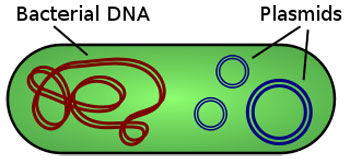
Plasmids can live in more than one type of bacteria. And germs can trade them around. “Bacteria can rub up next to each other, stick out a tube called a pilus, stick it into their neighbor and inject a plasmid,” Harris explains. If a gene for antibiotic resistance is on that plasmid, the receiving bacterium will become resistant, too.
The newly infected germ now can copy this plasmid and pass it on again. “It’s a bit like having the answers to an exam in your pocket,” Harris says. An exam might be impossible, but if one kid has the answers written down, all he has to do is pass that note to everyone else. Soon the whole class will have the information. In the case of germs, a shared plasmid can move one resistant gene to a diverse community of different germs.
Scientists have found colistin resistance on chromosomes before, but never on a plasmid. Until now. The scientists looking at livestock in China found they had a plasmid with such a gene. They isolated the plasmid from bacteria in a pig and called the gene mcr-1.
Bacteria had already been passing the plasmid from germ to germ and animal to animal. Between 2011 and 2014, the Chinese teams found it in more than one in every five animals they tested. They also it found in almost one in every seven cuts of raw meat that they tested from supermarkets.
But so far, the scientists have seen the plasmid in only one percent of patients infected with bacteria. This means that while the plasmid has traveled across farms in several provinces of China, it hasn’t taken hold in hospitals, where it could infect people who already are very sick.
Doi, Liu, Shen and their groups published their new findings November 18 in the scientific journal Lancet Infectious Diseases.
Don’t panic
“It’s not too surprising this happened,” says Smith at Kent State University. But while the new finding is worrying, it does not mean that all antibiotics are useless. That’s because the plasmid is not yet in many patients.
Moreover, plasmid-carrying bacteria don’t yet have the genes that would allow them to ignore all other antibiotics. So they still can be killed by some drugs. Smith says the finding means it’s not time to panic. It’s time to be careful.
“We need to be more prudent in our use of antibiotics,” says Michael Doyle. He studies food safety at the University in Georgia in Athens. Drugs such as colistin, which are so important for treating people, need to be withheld from use in animals — at least until absolutely necessary, he says. And, he adds, doctors need to restrict their use in people, too.
Colds and flu are caused by viruses — small packets of genetic material in protein coats. Antibiotics cannot kill viruses. So doctors should never prescribe such drugs to treat viral disease. And if patients don’t need these medicines, Doyle says, they shouldn’t get them. Every time an antibiotic is used, the risk grows that germs will evolve to resist it.
It’s also important to be aware of the risk for antibiotic resistance showing up elsewhere — especially in the kitchen. “Remember, there are millions of bacteria living on [meat] products,” says Smith. “Handle [them] with care. Wash your hands after you handle [meat].” If people handle raw meat and cooked meat together, she explains, the bacteria from the raw meat could get onto the cooked product — and then onto a dinner plate.
When possible, Smith recommends getting meat from local animals, because their meat “tends to come from smaller farms.” Small farms tend to use fewer antibiotics, she points out. Products from organic producers are another option. “They can’t use antibiotics,” she explains, unless their animals get sick.
Choosing to avoid meat that has been treated with antibiotics sends a message to farmers, too, Smith says. It might encourage them to cut their use of antibiotics in the future, slowing the development of drug resistance.
Scientists around the world have already begun hunting down the mcr-1 plasmid. They are searching for the tiny DNA loop in old bacterial samples. And some have already popped up — in samples of bacteria in Denmark from 2012.
“How quickly they [found the plasmid in Denmark] is interesting and impressive, but I’m not totally surprised,” Doi says. Now that scientists know what to look for, it will be a lot easier to find out if colistin resistance has spread — and where. Doi says that more studies of historical bacterial collections may also turn up mcr-1. Indeed, he muses, “I should look at my own collection of bacteria.”
Power Words
(for more about Power Words, click here)
antibiotic A germ-killing substance prescribed as a medicine (or sometimes as a feed additive to promote the growth of livestock). It does not work against viruses.
bacterial Having to do with bacteria, single-celled organisms. These dwell nearly everywhere on Earth, from the bottom of the sea to inside animals.
bacterium (plural bacteria) A single-celled organism. These dwell nearly everywhere on Earth, from the bottom of the sea to inside animals.
cell The smallest structural and functional unit of an organism. Typically too small to see with the naked eye, it consists of watery fluid surrounded by a membrane or wall. Animals are made of anywhere from thousands to trillions of cells, depending on their size.
chromosome A single threadlike piece of coiled DNA found in a cell’s nucleus. A chromosome is generally X-shaped in animals and plants. Some segments of DNA in a chromosome are genes. Other segments of DNA in a chromosome are landing pads for proteins. The function of other segments of DNA in chromosomes is still not fully understood by scientists.
colistin An antibiotic used in people when all other drugs have failed. It is a type of drug known as a polymyxin.
DNA (short for deoxyribonucleic acid) A long, double-stranded and spiral-shaped molecule inside most living cells that carries genetic instructions. In all living things, from plants and animals to microbes, these instructions tell cells which molecules to make.
evolve (adj. evolving) To change gradually over generations, or a long period of time. In living organisms, the evolution usually involves random changes to genes that will then be passed along to an individual’s offspring. These can lead to new traits, such as altered coloration, new susceptibility to disease or protection from it, or different shaped features (such as legs, antennae, toes or internal organs). Nonliving things may also be described as evolving if they change over time. For instance, the miniaturization of computers is sometimes described as these devices evolving to smaller, more complex devices.
gene (adj. genetic) A segment of DNA that codes, or holds instructions, for producing a protein. Offspring inherit genes from their parents. Genes influence how an organism looks and behaves.
genetic Having to do with chromosomes, DNA and the genes contained within DNA. The field of science dealing with these biological instructions is known as genetics. People who work in this field are geneticists.
genome The complete set of genes or genetic material in a cell or an organism. The study of this genetic inheritance housed within cells is known as genomics.
germ Any one-celled microorganism, such as a bacterium, fungal species or virus particle. Some germs cause disease. Others can promote the health of higher-order organisms, including birds and mammals. The health effects of most germs, however, remain unknown.
growth promoter (in livestock agriculture) A medicine, usually an antibiotic, added in small doses to the feed given to animals raised for meat. Used as a preventive medicine, it can reduce the risk that animals will become sick, which would slow their growth. And that would decrease a farmer’s profits.
livestock Animals raised for meat or dairy products, including cattle, sheep, goats, pigs, chickens and geese.
microbiology The study of microorganisms, principally bacteria, fungi and viruses. Scientists who study microbes and the infections they can cause or ways that they can interact with their environment are known as microbiologists.
molecule An electrically neutral group of atoms that represents the smallest possible amount of a chemical compound. Molecules can be made of single types of atoms or of different types. For example, the oxygen in the air is made of two oxygen atoms (O2), but water is made of two hydrogen atoms and one oxygen atom (H2O).
mutation Some change that occurs to a gene in an organism’s DNA. Some mutations occur naturally. Others can be triggered by outside factors, such as pollution, radiation, medicines or something in the diet. A gene with this change is referred to as a mutant.
organic (in chemistry) An adjective that indicates something is carbon-containing; a term that relates to the chemicals that make up living organisms. (in agriculture) Farm products grown without the use of non-natural and potentially toxic chemicals, such as pesticides.
plasmid A small circular loop of DNA that is separate from the main chromosomal DNA of bacteria.
pilus (plural pili) A tiny hair-like structure found on a bacterium.
polymyxins A group of antibiotics that are used in people only when all other groups fail. They include the drug colistin. Polymyxins specifically attack gram-negative bacteria, including E. coli.
resistance (v. resist) In medicine, the reduced effectiveness of a drug to cure a disease, usually a microbial infection. (as in disease resistance) The ability of an organism to fight off disease.
virus Tiny infectious particles consisting of RNA or DNA surrounded by protein. Viruses can reproduce only by injecting their genetic material into the cells of living creatures. Although scientists frequently refer to viruses as live or dead, in fact no virus is truly alive. It doesn’t eat like animals do, or make its own food the way plants do. It must hijack the cellular machinery of a living cell in order to survive.


